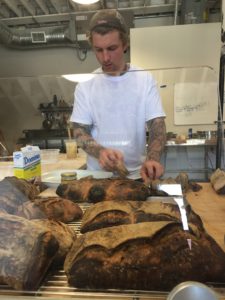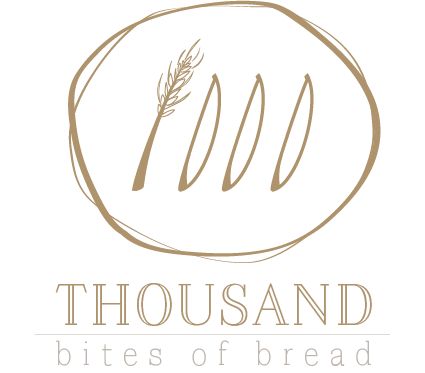Hello fellow bread lovers. Here’s the conundrum. I’m walking through a farmer’s market and I come across the most luxurious stand of pastries and breads. They’re piled high and brimming with ingredients that sing the seasons. A line is wrapped halfway around the block and the gentle baker stands at attention despite having been up since what most of us call middle-of-the-night. I fall in line sucking down a molasses & dark chocolate cold brew that I picked up at the kiosk next door. Then, after a lovely chat with the nice woman standing next to me who spends every Saturday morning as such, I miraculously get to the front. There I stand before sugar-sprinkled morning buns, everything croissants stuffed with cream cheese, and roasted pork & chimichurri pastries. There’s more. Sweet pistachio-laden cream spilling forth; baskets of bread; caramelized white chocolate with rhubarb. My heart is having palpitations as I try to narrow it down, but not before I manage to have a heart-to-heart with the baker. Clearly, she knows her stuff. Along with all the pastries, she’s also selling two different kinds of bread. As you know, my friends, bread is my heartbeat and I have at least a dozen burning questions to fire off before my turn in line is at an end. She is gracious and doesn’t hurry me along. Actually, she’s psyched to talk bread.
Yes, they’re both naturally leavened; not a commercial yeast granule in either one…
What kind of flour? 80% all purpose from King Arthur because that’s what her mentor used. The other 20% is whole wheat from Lindley Mills. She wishes to up the percentage in time as her skills grow…
Oh yes, long fermentation. Definitely!
The mother was acting strange this week; can’t figure out why, but looking into it. Maybe if I have time, would I get in touch and we can talk about keeping a mother healthy…?

I take my sack of cauliflower-roasted, butter-charged flaky goodness and cross the market taking slow, splendid bites.
Before I know it, I’m standing in front of another booth, this one relatively empty of customers and lined with plastic sacks of bread that look more like supermarket soldiers than freshly baked bread. This baker has a frenzied look in her eyes and she’s passing out pamphlets. She’s on a mission. She hands me a piece of paper and I read. This baker ardently wants everyone to know the virtues of freshly ground flour. I know; I get it. I share her passion. So why am I not more excited here? My litany of questions begins.
She gets the grains from all over. She doesn’t really know where or how they’re grown.
She grinds on a wondermill.
She made all the bread this week.
I pick up a loaf and look at the ingredients and it looks fine. Clean. Nothing unrecognizable. That said, I translate what I’m seeing and this loaf is not art, but the stern following of a recipe. Add a little of this, bloom some yeast, a dash of honey. Mix on high for however many minutes.
I buy a loaf.
So there you have it: One bread that is an imperfect amalgam of messy passion and a headlong dive into fermentation. Another loaf with little heart but a firm grasp of freshly ground flour.
Which do I choose? Which speaks to my real bread heart?
Both constitute food, of course. I think both even fall into the category of good food. They’re made by hand with fresh ingredients. And they both get me thinking: What is good bread?
Is good bread the art of fermentation? Or is it the use of superior grains or quality flour? Is it made by hand? Can it be made by machine? And if so, how mechanized can it be?
I guess the answer is that good bread can have any number of these factors and each type must be considered case-by-case. Ultimately, when we sit down to eat anything, it is a matrix of relationships to consider. What raw materials are available? What went into making or procuring this food? How hungry is the person eating? Is this the only food available? How sustainable, both for the body and for the planet? How much of this is pleasure and how much is nourishment? How entwined are these? Without getting too esoteric about the whole thing, I guess good bread, like good people, depends on a number of nuanced things.
If I were the type to choose strictly, my head would probably tell me to get the freshly ground whole grain bread for everyday. But I won’t.
Why? Because we are what we eat. I guess in the long run I’d rather ingest passion than rhetoric. I’d prefer to have the experience of eating the imperfect that is a striving dive into a mysterious world rather than eat the one that seems virtuous and all-buttoned-up. I think what hinders me most from the second loaf is how they’re all lined up like little clones. There is no flawed slash to tell them apart; they’re the same size, same shape. They mimic a lined-up-on-metal-shelves bread culture I’ve spent my life running from. Sure, they utilize an inkling of one of my most sought-after bread principles, but this bread isn’t stretching and growing and admitting to its limitations. It’s just sitting there in bags and that alone just won’t get me out of bed in the morning for my toast.
If I’m to be honest, both loaves make me want to rush home and bake. They both make me long to talk to more farmers who are growing grains; millers who are crushing them into fine flours; bakers who ardently share ideas of how to make a better, more-nourishing-in-every-way kind of loaf.

There are bakers out there doing it, friends. These pioneers spend time with our grains as if they’re spending time with their own children. They feed their starters; they visit the farms that are rearing their wheat, oats, barley and other grains. They get up day after day to try again and again to make food for the ages but make it better than even their ancestors did. This handful of bakers are masterful and deserve our unique attention.
Not two days before the above scene played out, I had a chance to taste bread from two bakers who know what’s what. More about Brooklyn Bread Lab and Jonathan Bethany soon.
In the meantime, here’s my wishlist, here’s what I make efforts to obtain in a daily loaf:
-Made with grains that are grown sustainably by farmers who make a good living. Ideally, this grain adds to the landscape of the farm and doesn’t disturb the microsystems of the soil where it grows.
-Made with stoneground flour that crushes the seed and uses all the micronutrient-drenched germ and bran, along with the endosperm. Ideally, the miller of this flour has a relationship with the farmer and knows how to coax out the grain’s best uses and communicate them to the baker.
-My daily loaf is naturally leavened with a well-fed, happy starter.
-Four main ingredients—flour, water, salt, levain— make up my daily loaf. I love the occasional visit from a seasonal guest or creativity from the baker showing through, of course. Variations of texture and flavor are welcome in say, a hazelnut fig bread in the fall or a taste memory from a baker that results in marble rye made with real flour (thank you, Matt!)
-Made by a baker who knows and loves the art of fermentation and is patient about letting the process unfold.
I’d love to hear your thoughts. What do you think makes good bread? For now, I think I’ll go toast myself a piece. I hope your daily bread brings you pleasure and nourishment this week. Settle for nothing less because the conundrum is worth it.


Definitely a slice of bread swirled with love…I admire those who have mastered the art of baking…But the mastery of thoughtful caring presentation and energy of the baker make bread oh so delicious.